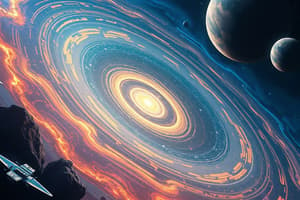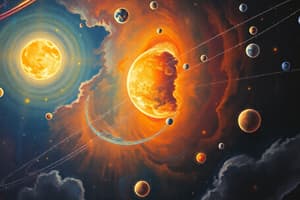Podcast
Questions and Answers
What is the primary process that led to the formation of the Sun?
What is the primary process that led to the formation of the Sun?
- Nebular Collapse (correct)
- Planetary Differentiation
- Thermonuclear Fusion
- Gregory's Model
Which planet is known for having a thick atmosphere that causes a runaway greenhouse effect?
Which planet is known for having a thick atmosphere that causes a runaway greenhouse effect?
- Mars
- Venus (correct)
- Mercury
- Earth
Which planet is closest to the Sun?
Which planet is closest to the Sun?
- Earth
- Mars
- Venus
- Mercury (correct)
What is primarily composed of hydrogen and helium in the solar system?
What is primarily composed of hydrogen and helium in the solar system?
Which celestial body is known to support life?
Which celestial body is known to support life?
What distinguishes Mars as the Red Planet?
What distinguishes Mars as the Red Planet?
Which planet has the largest moon in the solar system?
Which planet has the largest moon in the solar system?
What characterizes Saturn among the planets in the solar system?
What characterizes Saturn among the planets in the solar system?
What causes the blue-green color of Uranus?
What causes the blue-green color of Uranus?
Which of the following characteristics distinguishes terrestrial planets from Jovian planets?
Which of the following characteristics distinguishes terrestrial planets from Jovian planets?
What phenomenon do comets develop when they approach the Sun?
What phenomenon do comets develop when they approach the Sun?
Which planet is known for its extreme tilt and rotation on its side?
Which planet is known for its extreme tilt and rotation on its side?
What is a defining feature of the asteroid belt?
What is a defining feature of the asteroid belt?
What is primarily found in the Kuiper Belt?
What is primarily found in the Kuiper Belt?
Which spacecrafts were launched to explore the outer planets in 1977?
Which spacecrafts were launched to explore the outer planets in 1977?
Which of the following best describes meteoroids?
Which of the following best describes meteoroids?
Which rover was launched on November 26, 2011?
Which rover was launched on November 26, 2011?
What is the main goal of the Perseverance Rover?
What is the main goal of the Perseverance Rover?
When did the New Horizons mission fly by Pluto?
When did the New Horizons mission fly by Pluto?
What is the expected operational lifetime of the James Webb Space Telescope?
What is the expected operational lifetime of the James Webb Space Telescope?
What does the eccentricity of an orbit measure?
What does the eccentricity of an orbit measure?
Which mission provided the first close-up images of Pluto?
Which mission provided the first close-up images of Pluto?
What is the main purpose of the International Space Station (ISS)?
What is the main purpose of the International Space Station (ISS)?
What is the first step in drawing an ellipse using the two-foci method?
What is the first step in drawing an ellipse using the two-foci method?
What is the approximate semi-minor axis of Mars' orbit around the Sun?
What is the approximate semi-minor axis of Mars' orbit around the Sun?
Which of the following best describes the eccentricity of Mars' orbit?
Which of the following best describes the eccentricity of Mars' orbit?
What is the formula used to calculate the distance from Mars to the Sun at perihelion?
What is the formula used to calculate the distance from Mars to the Sun at perihelion?
How far from the Sun is Mars at its aphelion?
How far from the Sun is Mars at its aphelion?
What would be the distance from Mars to the Sun at perihelion?
What would be the distance from Mars to the Sun at perihelion?
Which relationship is correct based on the values of semi-major axis and eccentricity?
Which relationship is correct based on the values of semi-major axis and eccentricity?
What is the purpose of calculating both perihelion and aphelion distances?
What is the purpose of calculating both perihelion and aphelion distances?
What does the semi-major axis of Mars' orbit represent?
What does the semi-major axis of Mars' orbit represent?
Flashcards
Uranus
Uranus
An ice giant with a blue-green color due to methane in its atmosphere. It rotates on its side, making its tilt extreme compared to other planets.
Neptune
Neptune
An ice giant also known for its strong winds and storms. Its deep blue color comes from methane in its atmosphere.
Terrestrial Planet
Terrestrial Planet
A planet composed primarily of rock and metal, smaller in size and denser than Jovian planets with a thin atmosphere.
Jovian Planet
Jovian Planet
Signup and view all the flashcards
Asteroid
Asteroid
Signup and view all the flashcards
Comet
Comet
Signup and view all the flashcards
Dwarf Planet
Dwarf Planet
Signup and view all the flashcards
Moons
Moons
Signup and view all the flashcards
Mars Rovers
Mars Rovers
Signup and view all the flashcards
Perseverance Rover
Perseverance Rover
Signup and view all the flashcards
Orbit Eccentricity
Orbit Eccentricity
Signup and view all the flashcards
Drawing an Ellipse
Drawing an Ellipse
Signup and view all the flashcards
Semi-major axis (a)
Semi-major axis (a)
Signup and view all the flashcards
Eccentricity (e)
Eccentricity (e)
Signup and view all the flashcards
Semi-minor axis (b)
Semi-minor axis (b)
Signup and view all the flashcards
Perihelion
Perihelion
Signup and view all the flashcards
Aphelion
Aphelion
Signup and view all the flashcards
How to calculate the semi-minor axis (b)
How to calculate the semi-minor axis (b)
Signup and view all the flashcards
How to calculate the perihelion distance
How to calculate the perihelion distance
Signup and view all the flashcards
How to calculate the aphelion distance
How to calculate the aphelion distance
Signup and view all the flashcards
How did our Solar System form?
How did our Solar System form?
Signup and view all the flashcards
What are terrestrial planets?
What are terrestrial planets?
Signup and view all the flashcards
What is special about Mercury?
What is special about Mercury?
Signup and view all the flashcards
What makes Venus so hot?
What makes Venus so hot?
Signup and view all the flashcards
What is unique about Earth?
What is unique about Earth?
Signup and view all the flashcards
Why is Mars called the Red Planet?
Why is Mars called the Red Planet?
Signup and view all the flashcards
What are Jovian planets?
What are Jovian planets?
Signup and view all the flashcards
Why is Jupiter famous?
Why is Jupiter famous?
Signup and view all the flashcards
Study Notes
Formation of the Solar System
- The Nebular Hypothesis is the most accepted theory for the formation of the solar system
- About 4.6 billion years ago, a giant cloud of gas and dust (a nebula) collapsed under its gravity
- Most of the material was pulled toward the center to form the Sun
- Remaining material coalesced into planetesimals, which formed planets, moons, asteroids, and other bodies
Planets in the Solar System
Terrestrial Planets
- Mercury: Closest to the Sun, has a thin atmosphere, and extreme temperature variations. Its surface is heavily cratered
- Venus: Similar in size to Earth, but has a thick atmosphere rich in carbon dioxide, resulting in a runaway greenhouse effect. Surface temperatures are extremely high (hot enough to melt lead)
- Earth: The only known planet that sustains life; has a moderate climate and liquid water
- Mars: Known as the Red Planet; has a thin atmosphere (mostly carbon dioxide), the largest volcano and canyon in the solar system
Jovian Planets
- Jupiter: Largest planet; a gas giant, mainly hydrogen and helium, with a strong magnetic field and many moons, including Ganymede
- Saturn: Famous for its ring system, composed of ice and rock particles. It's also a gas giant
- Uranus: An ice giant with a blue-green color due to methane in its atmosphere. Its axis of rotation is tilted dramatically
- Neptune: Similar to Uranus, an ice giant with strong winds and storms, and a deep blue color due to methane
Other Astronomical Bodies
- Asteroids: Small rocky bodies primarily located in the asteroid belt between Mars and Jupiter
- Comets: Icy bodies originating from the Kuiper Belt or Oort Cloud. They develop tails when approaching the Sun
- Dwarf Planets: Smaller than planets but spherical; examples include Pluto, Eris, and Haumea
- Moons: Natural satellites orbiting planets; examples include Earth's Moon, Jupiter's Europa, Saturn's Titan
- Meteoroids, Meteors, and Meteorites: Small rocky or metallic bodies. Meteoroids are in space, meteors burn up in Earth's atmosphere, and meteorites reach Earth's surface
Space Explorations
- Historical Missions:
- Apollo Program: Landed humans on the Moon, including Apollo 11 in 1969
- Voyager Missions: Explored outer planets and are now interstellar space
- Modern Missions:
- Mars Rovers: Robots exploring the surface of Mars to search for signs of past life (e.g., Curiosity and Perseverance Rovers)
- James Webb Space Telescope: Powerful telescope designed to observe distant galaxies and study star and planet formation
- New Horizons: Mission to study Pluto and the Kuiper Belt
- International Space Station (ISS): Collaborative space laboratory in low Earth orbit
Orbital Characteristics
- Eccentricity: A measure of how oval an orbit is.
- Low eccentricity means nearly circular orbit
- High eccentricity means elongated orbit
- Semi-major axis (a): The average distance from a planet to the sun.
- Semi-minor axis (b): Related to the semi-major axis and the eccentricity.
- Perihelion: Closest point to the sun in a planet's orbit
- Aphelion: Farthest point from the sun in a planet's orbit.
- Ellipse: The shape of most planetary orbits.
Studying That Suits You
Use AI to generate personalized quizzes and flashcards to suit your learning preferences.




